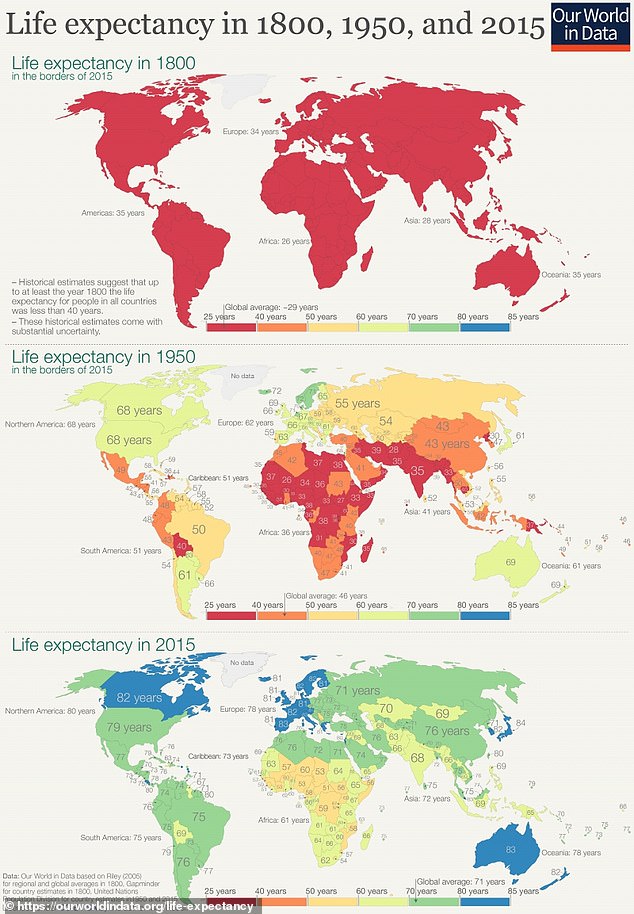Will YOU live until you’re 100? Online calculator works out your average life expectancy
Some of us are desperate for the answer. Others can think of nothing worse.
But those who want a glimpse into their future to see when they will die need look no further – because a fascinating online calculator can solve the riddle for you.
The tool, created by tHe Bureau of National Statistics (ONS), simply asks for your age and gender before calculating your life expectancy. For example, a 28-year-old man can expect to live until he turns 85.
But, as the widget based on government data shows, there’s a 7.7 percent chance they’ll live to be 100 years old.
It comes as new data today revealed that UK life expectancy has fallen in the world rankings, with only the US faring worse among advanced economies.
USERS OF THE MAILONLINE APP CAN USE BOTH TOOLS BY CLICKING HERE
Meanwhile, other ONS data breaks down life expectancy in the UK.
For example, a boy born in Westminster can expect to live to be 85, but a boy born in Glasgow is likely to live only 74.
Meanwhile, a girl born in Kensington and Chelsea should live to be 87, but their peers in Glasgow will probably only live to be 78.
Those numbers, based on children born between 2018 and 2020, are bundled in a fascinating interactive map.
The separate tool calculates the life expectancy of an individual at any age.
It is based on a range of data, including historical and projected mortality rates.
By calculating the male and female figures separately, the death registrations in the period 2018 to 2020 per age group, the probability of death and numbers of survivors per group are assumed.
One in five girls born in Britain is now expected to reach the age of 100, according to government analysts behind the calculator.
The ONS says boys born in the same year have a slightly lower chance of reaching their centenarian age — 13.6 percent — in line with the historical trend for women to live longer than men.
On average, boys born in 2020 can expect to live to age 87 and girls are likely to exceed 90, the bureau said.
It comes after academics from the University of Oxford and the London School of Hygiene and Tropical Medicine examined global life expectancy between 1952 and 2021.
The figures showed that the UK has underperformed all G7 countries except the US in seven decades, with the UK now falling to 36th place out of 200 in the world rankings.
Average life expectancy in the UK has increased from 68.63 years in 1950 to 80.43 years in 2020, compared to 68.06 and 77.41 years in the US, respectively, the data found.
However, these improvements have not kept pace with countries like Norway and Sweden, where people can now expect to live to 83.20 and 82.43, respectively.
In the UK, male life expectancy is projected to reach 79.4 years nationally by 2020 – the highest of all four countries, according to the ONS.
It was lowest in Scotland at 76.8 years.
Data suggests it was also highest for women in England at 83.1 years, but lowest in Scotland at 81 years.
The gap in male life expectancy between local areas in the UK grew from exactly 10 years in 2015 to 2017 to 11.6 years in 2018 to 2020.
For women, it increased from 7.8 years to 9.6 years.
Yet the ONS report only includes data from the first year of the pandemic.
The chart shows how each G7 country fared in international life expectancy rankings each year from 1950 to 2020. While Japan climbed from 45th to 3rd, the UK dropped from 10th to 36th and the US plummeted from 13th to 3rd. 53rd. It is based on data from academics at the University of Oxford and the London School of Hygiene and Tropical Medicine, who examined global life expectancy

A map showing the change in life expectancy between 1800, 1950 and 2015 illustrates the drastic global gap
Covid is believed to have increased inequality even further.
Experts fear the pandemic has exacerbated health inequality, with some attributing this to health care cuts and austerity.
Dr. Lucinda Hiam, from the University of Oxford, commented on data released today: ‘In the short term, the government is facing an acute crisis. However, a relative deterioration in public health is evidence that all is not well.
“It is historically an early sign of serious political and economic problems.
“This new analysis suggests that the problems facing the UK are deep-rooted and raises serious questions about the path this country is taking.”
